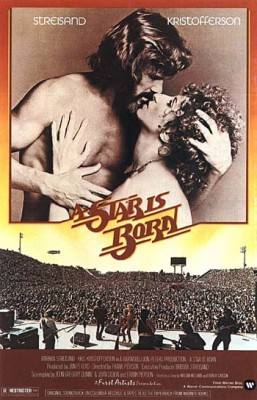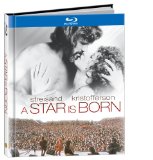| Reviews & Columns |
|
Reviews DVD TV on DVD Blu-ray 4K UHD International DVDs In Theaters Reviews by Studio Video Games Features Collector Series DVDs Easter Egg Database Interviews DVD Talk Radio Feature Articles Columns Anime Talk DVD Savant Horror DVDs The M.O.D. Squad Art House HD Talk Silent DVD
|
DVD Talk Forum |
|
|
| Resources |
|
DVD Price Search Customer Service #'s RCE Info Links |
|
Columns
|
|
|
Star Is Born (1976), A
One area in which A Star Is Born does not disappoint is the audio. An early Dolby System release, it was effectively the first film in Dolby Surround. While there's very limited directionality in terms of dialogue and sound effects, the film's many concert scenes all sound fantastic. The Blu-ray also ports over older extras, hinting at but somewhat whitewashing what apparently was an extremely contentious production.
The 1976 version moves the setting from the motion picture industry of the earlier films to the world of pop music. The plot, however, is much the same. John Norman Howard (country singer-songwriter-actor Kristofferson) is a self-destructive, alcoholic rock star. On tour, he arrives late for his concerts and is belligerent with his audience, who seem to prefer Howard's older hits to new material. He meets Esther Hoffman (Streisand), one-third of a lounge act called The Oreos (the other two being African-American). He clumsily tries to seduce her, but she rebuffs his advances and treats him like an ordinary person instead of an over-indulged star, which appeals to him. As in previous versions, Howard uses his waning influence to propel her into the public eye and eventual stardom. They marry, but his drinking and self-loathing is beyond her best efforts to save him.
The problem with this A Star Is Born is pretty easy to identify. For starters Howard has virtually no redeeming features, coming off as little more than a petulant, disheveled drunk. In the '37 and '54, Howard's counterpart, actor Norman Maine, was equally self-destructive but he was also charming and sympathetic because he clearly struggles with his disease. He gamely fights it but also quickly realizes that it's a losing battle and that he's a goner. The only validation he finds in his last months is in helping Esther recognize and realize her potential as an actress (and, in the '54 film, also and primarily as a singer). The great tragedy of the story comes when he realizes that he's outlasted even that grand gesture.
There are tiny bits of this in Kristofferson's character, but not much. When about 50 minutes into the picture Howard suddenly smiles it's almost a shock, so thoroughly grouchy and unpleasant had he been up to that point.
Elvis Presley was everyone's first choice to play Howard, but infamous manager "Colonel" Tom Parker asked for too much money and top billing for Elvis instead of Streisand. It would have been worth even that. Though more popular than ever, physically Elvis was on the same slippery slope as Howard yet, unlike Kristofferson's aloof mean-drunk portrait, Elvis's innate charm and likability, to say nothing of his live performance skills, doubtlessly would have been preferable, and the film could have marked a major comeback. If only.
Tied to this is Streisand's character, which seems to have been subtly retooled at her insistence. The changes throw the entire story off-balance. Director and co-writer Frank Pierson described her this way, "The woman in our story is ambitious to become a star, but it is not necessary: it can make her happier and richer, but she could give it all away and not be a better or worse person. With stardom she is only a little more than a woman."
In other words, she's ambivalent toward furthering her career, and once she does become phenomenally successful, a Big Star, she takes it in stride, perhaps as Streisand saw herself. But the two earlier Esthers suffered from a lack of confidence, an uncertainty about just how good they were at what they did. Norman Maine recognized a quality in them they didn't themselves see. Further, in the first act she needs him: he hooks her into believing in herself but only to a point. Norman Maine is still her lifeline. Streisand, presumably, wanted to play a stronger, more self-reliant character but this changes the entire dynamic between Esther and Howard.
Finally, the Hollywood depicted at the beginning of the '37 and '54 versions is initially seen with all the glamour and excitement people that don't live and work there usually associate with the place. Only later in the film is its unseemly side exposed. But the '76 film shows virtually only the sleazy, unrewarding side of the music business and, though it's hinted at here and there, rarely do Esther and Howard express a similar passion for songwriting and performing, that it's something they just gotta do.
Video & Audio
A Star Is Born is presented in its original 1.85:1 widescreen format. It looks okay for a 36 year-old film but as noted above the real pleasure is in listening to its early creative use of the Dolby System, here remixed as 5.1 DTS-HD Master Audio and which rocks during the concerts scenes. 1.0 French and Spanish audio is available, and subtitles in all three languages. (My Japanese player defaulted to hidden Japanese language options.) The disc is region free.
Extra Features
Supplements include older extras from the 2006 DVD (which date back to the laserdisc, perhaps?): an intermittent audio commentary by Streisand, who also provides optional commentary over a selection of deleted scenes, alternate takes, and costume tests. A trailer gallery rounds out of the supplements.
Parting Thoughts
Not terrible but several big notches below the 1954 version especially, the 1976 A Star Is Born has several memorable songs and at times plays like a pseudo concert film (with one extended pseudo-documentary sequence), but the changes made to the original story alter the characters in ways that just don't work. Recommended nonetheless.
Stuart Galbraith IV is a Kyoto-based film historian whose work includes film history books, DVD and Blu-ray audio commentaries and special features. Visit Stuart's Cine Blogarama here.
|
| Popular Reviews |
| Sponsored Links |
|
|
| Sponsored Links |
|
|
| Release List | Reviews | Shop | Newsletter | Forum | DVD Giveaways | Blu-Ray | Advertise |
|
Copyright 2024 DVDTalk.com All Rights Reserved. Legal Info, Privacy Policy, Terms of Use,
Manage Preferences,
Your Privacy Choices | |||||||















